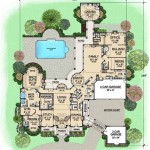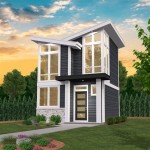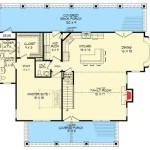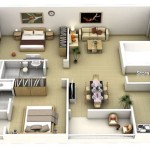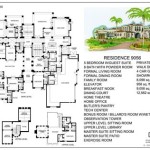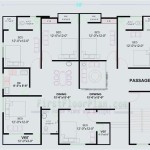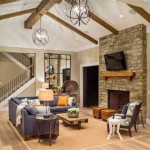House Plans With Detached In-Law Suite: Exploring Options for Multi-Generational Living
The demand for housing solutions that accommodate multiple generations under one extended roof is steadily increasing. Several factors contribute to this trend, including rising property costs, an aging population, and a desire for closer family ties. House plans with detached in-law suites, also known as accessory dwelling units (ADUs), offer a unique solution that balances independence and proximity. These suites provide a separate living space for family members while maintaining a degree of privacy and autonomy for all involved. This article will explore the benefits, design considerations, and practical aspects of choosing a house plan with a detached in-law suite.
Benefits of Detached In-Law Suites
Detached in-law suites offer several advantages over integrated or attached versions. The primary benefit is the enhanced sense of privacy for both the primary residents and the suite occupants. A separate structure minimizes noise transfer and provides a distinct living space. This separation is crucial for maintaining harmonious relationships and avoiding the potential conflicts that can arise from close proximity. Another advantage is the flexibility they provide. Detached units can be adaptable to different needs over time. They can serve as a home office, a rental unit for supplemental income (where permitted by local regulations), or even a guest house. This versatility makes them a valuable long-term investment.
Furthermore, detached suites can offer increased property value. While the impact varies depending on location and market conditions, adding a functional and well-designed ADU generally boosts the overall desirability and value of the property. Potential buyers often appreciate the suite's potential for multi-generational living, rental income, or flexible use as their needs evolve. Finally, detached units often allow for more design flexibility. Unlike attached suites, which must integrate with the existing structure, detached units can be designed to complement the primary residence or to stand as a distinct architectural element.
Key Design Considerations for Detached In-Law Suites
Designing a detached in-law suite requires careful consideration of several factors to ensure functionality, comfort, and compliance with local regulations. Size and layout are crucial elements. The square footage should be adequate to provide a comfortable living space, including a sleeping area, bathroom, kitchenette or full kitchen, and living area. The layout should be designed to maximize space utilization and accessibility, especially if the suite is intended for elderly or disabled occupants. Universal design principles, such as wider doorways, grab bars in bathrooms, and level thresholds, should be incorporated to enhance accessibility and safety.
Another important consideration is the connection to utilities. The suite will need to be connected to the main house's water, sewer, and electrical systems, or it may require its own independent systems. The cost and feasibility of these connections should be carefully evaluated during the planning phase. Energy efficiency is also a key design consideration. Incorporating energy-efficient windows, insulation, and appliances can significantly reduce utility costs and minimize the environmental impact. Sustainable building materials, such as reclaimed wood or recycled content products, can further enhance the suite's eco-friendliness.
Finally, the architectural style of the suite should complement the primary residence and the surrounding neighborhood. The design should be cohesive and aesthetically pleasing, enhancing the overall curb appeal of the property. Landscaping can also play a significant role in integrating the suite into the existing landscape and creating a sense of privacy and separation.
Navigating Legal and Regulatory Requirements
Building a detached in-law suite involves navigating a complex web of legal and regulatory requirements. Zoning regulations are the primary factor influencing the feasibility and design of an ADU. Zoning ordinances dictate the permitted uses of the property, the minimum lot size, the maximum building height, and the required setbacks from property lines. These regulations vary significantly from jurisdiction to jurisdiction, so it is essential to thoroughly research the local zoning laws before proceeding with any design or construction work.
Building codes also play a crucial role in ensuring the safety and structural integrity of the suite. Building codes specify the minimum standards for construction materials, electrical wiring, plumbing, and other building systems. Compliance with building codes is mandatory and requires obtaining the necessary building permits and inspections. Furthermore, some jurisdictions may have specific requirements for ADUs, such as restrictions on the size or number of occupants. These regulations are often aimed at addressing concerns about increased density and potential impacts on neighborhood character.
In addition to zoning and building codes, homeowners associations (HOAs) may also have restrictions on ADUs. HOA covenants and restrictions can prohibit or limit the construction of accessory dwelling units, so it is essential to review these documents before proceeding with any plans. Obtaining the necessary permits and approvals can be a lengthy and complex process, so it is advisable to consult with a qualified architect, contractor, or zoning consultant to ensure compliance with all applicable regulations. Failing to comply with these regulations can result in costly fines, delays, or even the forced removal of the unauthorized structure.
Financing the construction of a detached in-law suite can be approached in several ways. Home equity loans and lines of credit are common options, allowing homeowners to borrow against the equity in their existing property. Construction loans are specifically designed to finance building projects, providing funds that are disbursed in stages as the project progresses. Alternatively, personal loans or savings can be used to fund the construction. The best financing option will depend on the homeowner's individual financial situation, credit score, and available equity. It is crucial to shop around and compare different loan products to find the most favorable terms and interest rates.
The addition of a detached in-law suite can also impact property taxes. In most jurisdictions, the assessed value of the property will increase to reflect the addition of the new structure, resulting in higher property taxes. The exact amount of the increase will depend on the size, quality, and location of the suite. It is advisable to consult with the local property tax assessor to get an estimate of the potential tax impact before proceeding with construction.
Choosing a house plan with a detached in-law suite can be a beneficial decision for many families. It contributes to increased living space, privacy, and flexibility. However, careful planning and consideration of the legal, regulatory, and financial aspects is paramount before undertaking such a project. This comprehensive approach will help to ensure that the in-law suite addition is a successful and valuable investment.

Homes With Mother In Law Suites

Exclusive 4 Bed House Plan With Detached In Law Suite 93109el Architectural Designs Plans

House Plan 65862 Tuscan Style With 2091 Sq Ft 3 Bed 2 Bath 1

House Plans With In Law Suites Houseplans Blog Com

Country House Plan With 4 Bedrooms And 3 5 Baths 4427

In Law Suite Plans Give Mom Space And Keep Yours The House Designers

Exclusive 4 Bed House Plan With Detached In Law Suite 93109el Architectural Designs Plans

House Plans With In Law Suites Houseplans Blog Com

Find The Perfect In Law Suite Our Best House Plans Dfd Blog

Adding An In Law Suite Designing Your Perfect House

